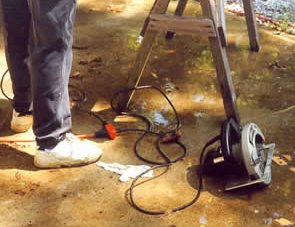Evaluating Your Risk
After you recognize a hazard, your next step is to evaluate your risk from the hazard.

The closer you work to the "danger zone," the more likely you are to be exposed to the electrical hazard. For instance, exposed wires should be recognized as a hazard. If the exposed wires are 15 feet off the ground, you're not close to the danger zone so the risk is low. However, if you are going to be working on a roof near those same wires, your risk is high. The risk of shock is greater if you will be carrying metal conduit that could touch the exposed wires. It's important that as you work throughout the day, you constantly evaluate your risk.
Another factor that increases your risk of injury is working around a combination of hazards. For example, using a defective, improperly grounded tool, in wet conditions would create a situation in which a combination of hazards exist.
There may be important clues that electrical hazards exist. For example, if a GFCI keeps tripping while you are using a power tool, that's a clue that there is a problem. Don't keep resetting the GFCI and continuing to work. You must evaluate the "clue" and decide what action should be taken to control the hazard.
Any of these conditions, or "clues," tells you something important: there is a risk of fire and electrical shock. The equipment or tools involved must be avoided. You will frequently be caught in situations where you need to decide if these clues are present. A maintenance electrician, supervisor, or instructor should be called if there are signs of overload and you are not sure of the degree of risk. Ask for help whenever you are not sure what to do. By asking for help, you will protect yourself and others.
Each worker has a personal responsibility to take safety seriously. While employers provide training, tools, and safe procedures, you must remain alert and take ownership of your actions. Staying aware of your surroundings, following safety protocols, and choosing safe behaviors help protect not only yourself but also your coworkers. Remember, your safety is ultimately in your own hands.
Knowledge Check Choose the best answer for the question.
6-1. Working with a defective electrical tool on wet ground would be an example of increased risk due to _____.
You forgot to answer the question!
